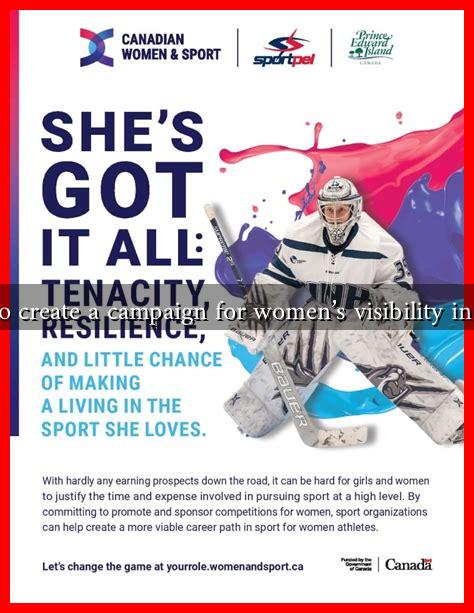-
Table of Contents
How to Create a Campaign for Women’s Visibility in Sports
Women’s participation in sports has seen significant growth over the past few decades, yet visibility remains a critical issue. Despite the increasing number of female athletes, media coverage and sponsorship opportunities often lag behind their male counterparts. A well-structured campaign can help elevate women’s visibility in sports, fostering a more inclusive environment. This article outlines key steps to create an effective campaign aimed at enhancing women’s visibility in sports.
Understanding the Landscape
Before launching a campaign, it’s essential to understand the current landscape of women in sports. According to a report by the Women’s Sports Foundation, only 4% of sports media coverage is dedicated to women’s sports. This stark disparity highlights the need for targeted efforts to increase visibility.
Setting Clear Objectives
Every successful campaign begins with clear objectives. Here are some potential goals for a campaign focused on women’s visibility in sports:
- Increase media coverage of women’s sports by 50% within a year.
- Raise awareness about female athletes and their achievements.
- Encourage brands to invest in women’s sports sponsorships.
- Engage communities to support local women’s sports teams.
Identifying Your Target Audience
Understanding your target audience is crucial for tailoring your message effectively. Consider the following groups:
- Sports fans who may not be aware of women’s sports.
- Young girls who aspire to be athletes.
- Parents and coaches who influence young athletes.
- Brands and sponsors looking for partnership opportunities.
Crafting Your Message
Your campaign message should resonate with your audience and highlight the importance of women’s visibility in sports. Here are some key elements to include:
- Highlight success stories of female athletes, such as Serena Williams or Megan Rapinoe, who have made significant impacts in their sports.
- Use statistics to illustrate the disparity in coverage and support for women’s sports.
- Emphasize the benefits of increased visibility, such as inspiring the next generation of female athletes.
Utilizing Multiple Platforms
To maximize reach, leverage various platforms for your campaign:
- Social Media: Use platforms like Instagram, Twitter, and TikTok to share stories, statistics, and visuals that promote women’s sports.
- Traditional Media: Partner with local newspapers and radio stations to feature stories about women athletes.
- Events: Organize community events, workshops, or panels that focus on women in sports.
Engaging Influencers and Ambassadors
Collaborating with influencers and ambassadors can amplify your campaign’s reach. Consider the following:
- Engage female athletes who can share their experiences and advocate for visibility.
- Partner with organizations that support women in sports, such as the Women’s Sports Foundation or SheIS.
- Utilize social media influencers who focus on sports and gender equality.
Measuring Success
To evaluate the effectiveness of your campaign, establish metrics for success. Consider tracking:
- Media coverage before and after the campaign.
- Engagement rates on social media platforms.
- Attendance at events and workshops.
- Increased sponsorship deals for women’s sports teams.
Case Study: The #LikeAGirl Campaign
The #LikeAGirl campaign by Always is a prime example of how to effectively promote women’s visibility. Launched in 2014, the campaign aimed to change the perception of what it means to do something “like a girl.” It successfully engaged audiences through social media, television ads, and community events, leading to a significant shift in public perception and increased discussions around gender equality in sports.
Conclusion
Creating a campaign for women’s visibility in sports requires a strategic approach that encompasses understanding the landscape, setting clear objectives, and engaging the right audiences. By crafting a compelling message and utilizing various platforms, you can effectively raise awareness and inspire change. Remember, the goal is not just to increase visibility but to foster a culture that celebrates and supports women in sports. Together, we can create a more equitable future for female athletes.
For more information on promoting women in sports, visit the Women’s Sports Foundation.

